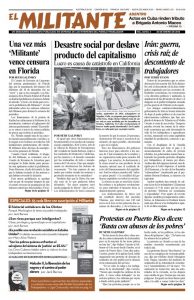Below is an excerpt from “Vorkuta (1950-53): Oppositional currents and the mine strikes” from Samizdat: Voices of the Soviet Opposition, one of Pathfinder’s Books of the Month for January. The author, Brigitte Gerland, an East German communist, spent some eight years in Stalin’s prisons and camps.
After Joseph Stalin’s death in 1953, a powerful strike wave swept the regime’s deadly prison camps in the early 1950s. The key challenge that faced workers there was the deep divisions that existed among prisoners from Russia on the one hand and those from Ukraine and the Baltic States on the other. In some of the camps in Vorkuta, Ukrainians comprised half of the prisoners.
Communists — who were followers of V.I. Lenin and Leon Trotsky and imprisoned for their work opposing the Stalinist regime — led the strikes. It took three years of persistent work to overcome the divisions among the prisoners, which were bolstered by the guards, and forge a common political program to fight the brutal conditions in the camp. Copyright © 1974 by Pathfinder Press. Reprinted by permission.
BY BRIGITTE GERLAND
Many who had opposed the movement until then, particularly among the zapadniki [Ukrainians and Balts], now realized that the hour for action was at hand. They started joining the strike committees, as yet, to be sure, only in the camps under the leadership of the Marxists and the monashki [religious groups]. So tense became the atmosphere that everyone was electrified. Committees of Pits No. 1 and No. 7, where the Leninists and the anarchists exercised the strongest influence, decided — with the unanimous support of forced laborers at these camps, totaling some 6,000 — to strike until the government agreed to dissolve the camps and grant to all prisoners the status of free colonists. That is to say, to treat them as free laborers, and to sign three-to-five year contracts with them.
This compromise program of action was needed to win over those prisoners who still hesitated and who would have never accepted the slogan of a strike for unconditional liberation. Work was to stop on the evening of July 20, but that same morning the Pit No. 1 strike committee, recognized by the forced laborers of Vorkuta region as the central leadership of the strike, was arrested. This was done by deploying large contingents of troops who surrounded the pit suddenly and who withdrew just as suddenly two hours later, taking their prisoners along to the Vorkuta penitentiary. They were kept there for a few days and then removed to Moscow. The prisoners of Pit No. 1, however, quickly overcame their initial consternation; they elected a new strike committee. The military operation carried out by the authorities merely postponed the strike for a space of twelve hours.
In the early hours of July 21 the escorting guards stood waiting with their watch-dogs alongside the high fence gates, but there was no movement of any kind, absolutely nothing, inside the concentration city. The prisoners sat silently in their barracks, without the remotest intention of starting work. At first, the sentries on duty made their appearance to urge the recalcitrants to line up at the camp gates. And in their wake came a few officers of the camp administration and, finally, the camp chief himself. But their efforts availed nothing, except a declaration to the effect that the strikers would not present their demands to any person other than the commandant of all the Vorkuta camps, General Derevyanko.
This dignitary put in his appearance two days later, only after ten pits inside the city and on the outskirts joined the strike (involving by then some 30,000). After the strike committee delegates put forward their demands, the general made a long speech, larded with vague promises and threats which were not so vague. But he was butting his head against a wall of hostile silence. …
In the first days of August, when the strike reached its peak and when even some among the MVD [Ministry of Internal Affairs] officers were sure the prisoners had carried the day, the state prosecutor, with his retinue of generals, landed at the tiny Vorkuta airfield. He set up his headquarters in the city for several days, in order, he declared, to negotiate and reach a worthwhile agreement.
In an imposing briefcase he had brought with him a number of concessions which were promptly broadcast through all the camps:
1) Every prisoner in special “government camps” is granted permission, effective immediately, to write letters home twice a month, instead of twice a year;
2) each prisoner may receive, once a year, a visit from his family;
3) identification numbers shall be removed at once from trousers and jackets;
4) iron bars shall be removed from barracks windows.
These concessions, however, left the strikers cold. In an open letter to the state prosecutor, the strike leadership gave its answer:
“We are proud of our identification numbers, because they publicly distinguish us from common criminals and thieves; and that is why we have no desire to do away with them.
“Our families will not be able to visit us, not even with the kind permission of the MVD, because they haven’t enough money to buy railroad tickets for trips of 4,000 miles and more.
“Writing letters is a superfluous occupation for those who are dead, and that’s what we are, condemned to stay here for twenty-five years. We can do without writing letters unless we are granted through revised regulations, the possibility of returning to our families in the not too distant future.” …
[T]he material improvements to which the MVD was forced to agree under the strike pressure proved to be considerable. And more important by far: although there were many signs of exhaustion, there was not a hint of discouragement or demoralization.
The forced laborers were worn down, but they did not succumb in despair. Their aim was to rally new forces; they wished to draw carefully the lessons from their experiences in order to make better use of them in the future — and they were resolved to continue the struggle.

